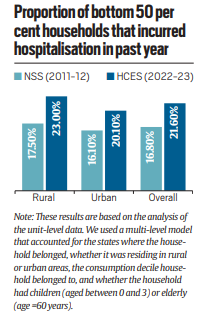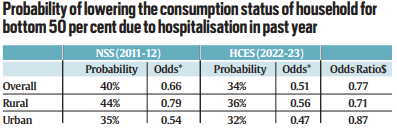9 August 2024 : Indian Express Editorial Analysis
1. Doing well on well-being
(Source: Indian Express; Section: The Ideas Page; Page: 15)
| Topic: GS2– Social Justice |
| Context: |
| The article analyzes data from the Household Consumption Expenditure Survey (HCES) 2022-23. |
What is the Household Consumption Expenditure Survey?
- The HCES is conducted by the National Statistical Office (NSO) every 5 years.
- It is designed to collect information on the consumption of goods and services by households.
- The data collected in HCES is also utilised for deriving various other macroeconomic indicators such as Gross Domestic Product (GDP), poverty rates, and Consumer Price Index (CPI).
- The average MPCE has been calculated at 2011-12 prices.
- The survey covered the whole of the Indian Union except a few inaccessible villages in the Andaman and Nicobar Islands.
- The findings of the last HCES, conducted in 2017-18 were not released after the government cited “data quality” issues.
Information Generated:
- Provides information on the typical spending on both goods (including food and non-food items) and services.
- Additionally, assists in calculating estimates for household Monthly Per Capita Consumer Expenditure (MPCE) and analysing the distribution of households and individuals across different MPCE categories.
Decline in Poverty and Focus on Vulnerability
- The analysis of the Household Consumption Expenditure Survey (HCES) 2022-23 reveals a significant decline in poverty incidence in India since 2011-12.
- While this is noteworthy, the focus here shifts to a more nuanced aspect of household welfare: vulnerability to adverse shocks. Particularly, the vulnerability of the bottom 50% of the population is of concern.
- The ability of households to cope with adverse shocks, such as unexpected medical expenses, is a critical measure of well-being.
- Quantifying this vulnerability, however, presents challenges that the study attempts to address by focusing on medical expenditure, specifically those arising from hospitalization.
Quantifying the Impact of Medical Shocks

- Medical shocks, especially those requiring hospitalization, impose a significant economic burden on households.
- The study first quantifies the proportion of Indian households exposed to these shocks.
- The incidence of hospitalization-related medical expenditure for the bottom 50% of the population increased from 17% in 2011-12 to 22% in 2022-23.
- This increase reflects improved access to healthcare, particularly among the poorest households in both rural and urban areas.
Medical Expenditure as a Share of Household Spending
- The study further analyzes the ratio of medical expenditure to overall household expenditure, comparing households with and without hospitalization events.
- For households without hospitalization, health expenditure as a share of monthly household expenditure increased slightly from 3.3% to 3.6% over the decade.
- However, for those experiencing hospitalization, this ratio declined significantly from 10.8% to 9.4%.
- This decline suggests that hospitalization-related healthcare costs have become more affordable for the poorest half of the population, particularly in rural areas.
Regional Differences in Medical Expenditure

- A closer look at rural and urban areas reveals distinct trends. In rural areas, the health expenditure ratio for the bottom 50% of households without hospitalization saw a marginal increase from 3.4% to 3.6%.
- In contrast, for households with hospitalization, the ratio dropped significantly from 11.15% to 9.14%.
- Urban households exhibited similar, though less pronounced, trends.
- These findings highlight a positive shift towards affordability of healthcare involving significant hospitalization expenses, especially in rural India.
Vulnerability and Consumption Status
- The study also examines the impact of medical expenditure on household consumption status, particularly for those burdened by hospitalization costs.
- Among the poorest 50% of the population, 40% of households that experienced hospitalization saw a decline in their consumption status in 2011-12.
- By 2022-23, this proportion had decreased to 33%, despite a rise in hospitalization incidence. This indicates a 23% reduction in the odds of households facing a decline in consumption status due to hospitalization.
Implications for Rural and Urban Households

- The reduction in vulnerability was more significant in rural areas, where the proportion of households experiencing a decline in consumption status due to hospitalization dropped from 44% in 2011-12 to 36% in 2022-23.
- This corresponds to a 29% reduction in the odds of poor rural households facing a decline in overall consumption status.
- In urban areas, the odds fell by 14% over the same period.
Conclusion: Improved Accessibility and Reduced Vulnerability
- Overall, the last decade has seen healthcare become more accessible and affordable for the bottom 50% of the Indian population.
- The study’s findings indicate a significant decline in the odds of households experiencing a loss in consumption status due to the financial burden of hospitalization, a strong indicator of reduced vulnerability.
- These positive trends are particularly evident in rural households and those with vulnerable family members, such as young children and the elderly.
- The improvements are closely linked to public health policies in India, notably the Ayushman Bharat Yojana, which aims to alleviate the financial burden of hospitalization for the poor.
| Formed in 2019 by merging the Central Statistical Office (CSO) and the National Sample Survey Office (NSSO).C. Rangarajan Committee first suggested the establishment of NSO as the nodal body for all core statistical activities.It currently works under the Ministry of Statistics and Programme Implementation (MoSPI).Function: Collects, compiles, and disseminates reliable, objective, and relevant statistical data. |
| PYQ: As per the NSSO 70th Round “Situation Assessment Survey of Agricultural Households”, consider the following statements: (2018) Rajasthan has the highest percentage share of agricultural households among its rural households.Out of the total agricultural households in the country, a little over 60 percent belong to OBCs.In Kerala, a little over 60 percent of agricultural households reported to have received maximum income from sources other than agricultural activities. Which of the statements given above is/are correct? (a) 2 and 3 only (b) 2 only (c) 1 and 3 only (d) 1, 2 and 3 Ans: c |
| Practice Question: The Household Consumption Expenditure Survey (HCES) 2022-23 highlights both a decline in poverty and the continued vulnerability of households to medical shocks, particularly among the bottom 50% of the population. Discuss the impact of healthcare accessibility and affordability on poverty reduction and household consumption patterns in India. How have recent public health policies, such as Ayushman Bharat Yojana, influenced these trends? (250 words/15 m) |




